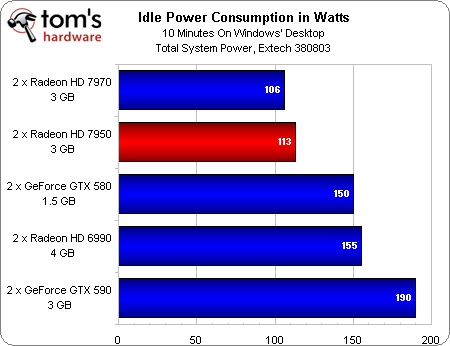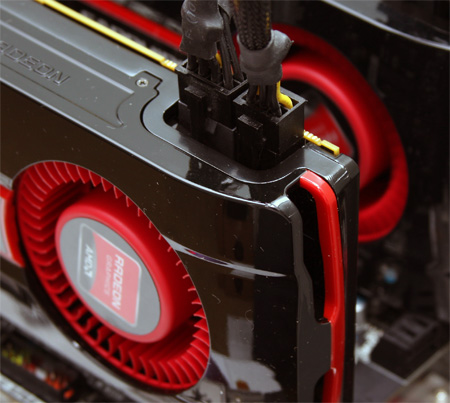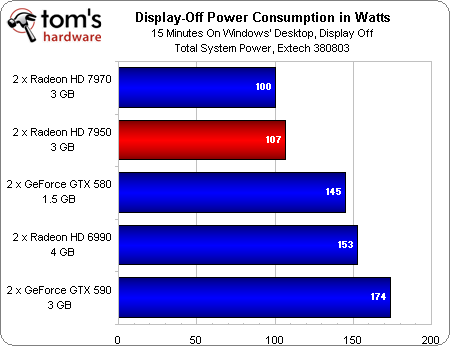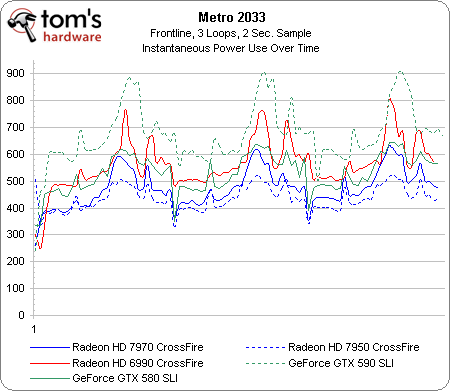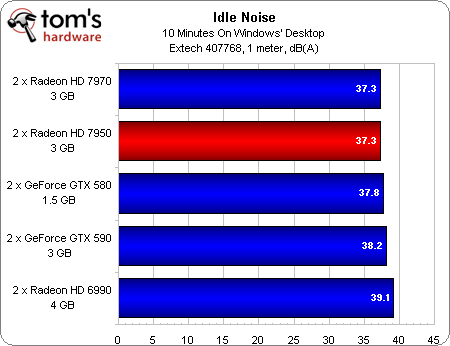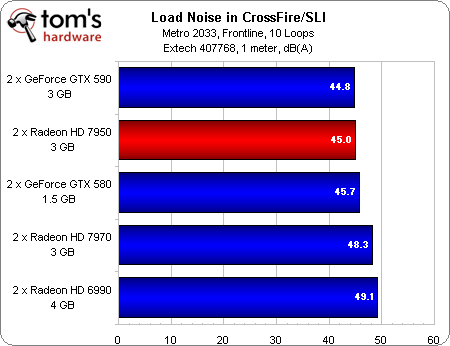AMD Radeon HD 7950 Review: Up Against GeForce GTX 580
CrossFire And SLI: Power Consumption And Noise
Power
Oddly, two Radeon HD 7970s use just slightly less power at idle than two Radeon HD 7950s. The point is, however, that they both draw a lot less than any other combination of cards.
And just look at those two GeForce GTX 590s sitting there, slurping down a whopping 84 W more than the 7970s on Windows' desktop!
If you flip back and forth between this page and the previous one, you'll notice that each 7900-series CrossFire setup is only using around the same amount of idle power as a single-card arrangement. That’s because they’re doing this:
That’s one card idling (in the back), its PCI Express 3.0 link throttling to 1.1 transfer rates to cut power, as the other card (up front) completely spins down.
As a result, you get even more impressive power results when output is cut to the attached display. The Radeon HD 7950 and 7970 CrossFire configs each shed an additional 6 W of consumption.
For their ability to deliver the fastest Metro 2033 results in CrossFire, beating quad-GPU Radeon HD 6990 and GeForce GTX 590 configurations, the Radeon HD 7970 and 7950 are also the two most power-friendly choices cards you could put together in multi-GPU arrangements.
Get Tom's Hardware's best news and in-depth reviews, straight to your inbox.
And that’s under load. We’ve already seen how much better they are at idle. If you were to calculate out the efficiency of these cards versus older AMD and Nvidia boards, they’d almost certainly stomp everything else out there. Performance per watt is where it’s at.
Noise
The Radeon HD 7900s again show well when it comes to keeping idle acoustic output to a minimum. Nvidia’s cards are similarly silent. And although the Radeon HD 6990s come in last place, they’re still hardly a distraction.
As long as you have a full expansion slot separating two dual-GPU cards, the noise generated by a CrossFire or SLI configuration isn’t markedly higher than one board operating on its own in the real-world gaming environment we’re testing.
AMD is using a centrifugal fan design that exhausts all of its heated air, which we applaud.
The only odd result here is the Radeon HD 6990s, which operate more quietly in a quad-CrossFire arrangement than one card flying solo. Fortunately, the explanation is pretty simple. Compared to two GeForce GTX 590s, which are fully taxed in Metro 2033, the 6990s hover between 60 and 80% GPU utilization according to GPU-Z.
Our presumption is that host overhead is higher, so we’re seeing a bottleneck that inhibits performance, which would explain why one 6990 was able to outmaneuver a 7970 at 2560x1600, but even two 7950s beat a pair of 6990s at the same resolution.
Current page: CrossFire And SLI: Power Consumption And Noise
Prev Page Power, Temperatures, And Noise Next Page One Year Later: A Great GeForce GTX 580 Alternative-
Im not Paying $450 for barely better then GTX 580 performance a year after its released. They will have to knock that down to like $300, $250 for a 2gb version when Nvidia releases their next gen cards. Wait those money grubers out imo.Reply
-
thesnappyfingers stm I was thinking the same thing. But then agian it is still cheaper, more efficient compared to the gtx 580. Still, I am waiting it out till kepler.Reply -
rmpumper 7950/7970 should be priced ~$50+ of 6950/6970 prices. So as it is now, if nvidia's gtx680 will be better than 7970 they will price it at >$600? That's a load of crock.Reply -
Derbixrace great value compared to the 7970 because you can OC it to be faster than it on stock voltage and even further with voltage tweaking ;)Reply -
esrever I'd love to have one once kepler comes and these drop in price. Im gonna start saving.Reply -
It beats the GTX580 one on one in most benchies and that's not taking into account the overclocking headroom these things have, they're also power friendlier and with XFX, cooler, quieter and expected to be cheaper so what's the problem? Me thinks me smell's NV fanboys!!Reply
-
dragonsqrrl rmpumper7950/7970 should be priced ~$50+ of 6950/6970 prices. So as it is now, if nvidia's gtx680 will be better than 7970 they will price it at >$600? That's a load of crock.Every rumor and leak I've seen so far on gk104 pricing seems to indicate otherwise...Reply
http://www.guru3d.com/news/nvidia-gk104-kepler-gpu-priced-at-299-230-/
According to Nvidia's AIB partners the initial price set for the first gk104 based graphics card is $300. Of course this can go up or down based on the competition. Unfortunately, I have the feeling it'll be going up.
